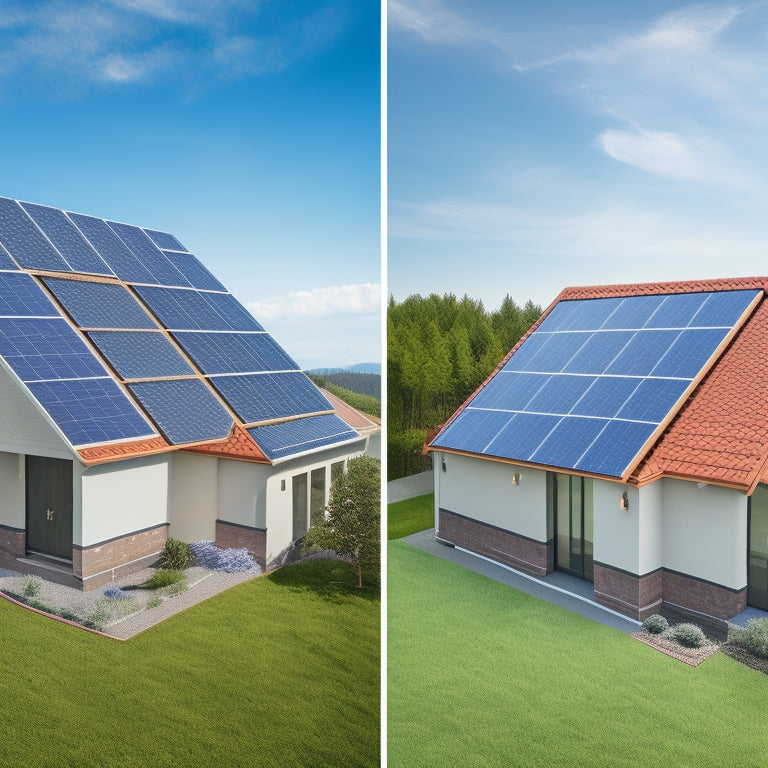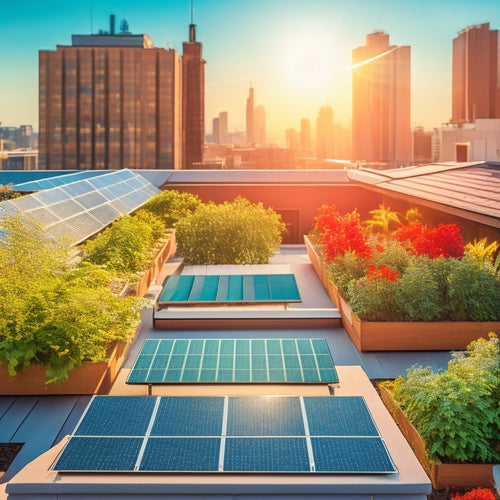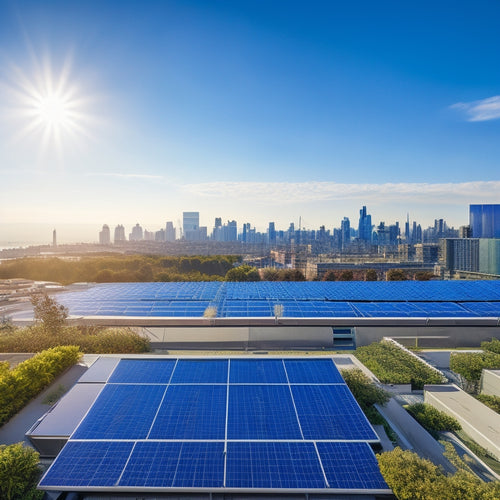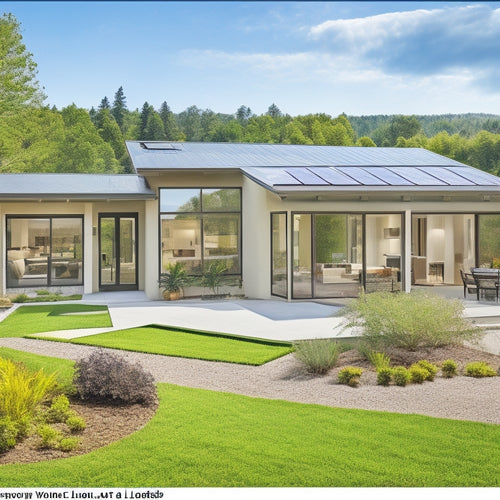
Avoiding Mistakes When Installing Solar Panels on Your Roof
Share
When installing solar panels on your roof, you'll want to avoid common mistakes that can compromise your roof's structural integrity, void warranties, and reduce energy output. You'll need to thoroughly assess your roof's condition, verifying it can support the weight of the panels, and choose a high-quality mounting system that can withstand environmental stressors. Proper panel placement is also essential, considering roof direction, shading, and panel angle. Don't forget to follow local building codes and plan for regular maintenance to prevent issues down the line. By sidestepping these common pitfalls, you'll be well on your way to a successful, efficient solar panel installation that pays off for years to come - and there's more to investigate to guarantee your project's success.
Key Takeaways
- Ensure a thorough roof assessment to identify potential structural issues before installing solar panels to prevent costly repairs or collapse.
- Invest in a high-quality mounting system that can withstand environmental stressors and is installed correctly to prevent water leaks and electrical issues.
- Optimize solar panel placement by evaluating roof direction, panel angle, and shading to maximize energy production and minimize energy loss.
- Comply with local building codes and permitting processes to avoid project delays, fines, and voided warranty and insurance coverage.
- Develop a maintenance plan with regular inspections and cleaning schedules to ensure optimal energy output and extend the system's lifespan.
Insufficient Roof Assessment
When you're considering solar panels, you naturally focus on the system itself, but it's equally vital to evaluate the roof that will be supporting it. A thorough roof evaluation is essential to guarantee a safe and efficient solar panel installation.
You must examine the roof's age, as an older roof may not be able to support the weight of the solar panels. Additionally, you need to inspect the roof's structural integrity, checking for signs of wear and tear, such as cracks, corrosion, or damaged flashing.
A roof with compromised structural integrity can lead to costly repairs or even collapse under the weight of the solar panels. Furthermore, a roof that's nearing the end of its lifespan may not be able to withstand the additional weight and stress of the solar panel system.
By evaluating the roof's condition, you can determine if repairs or replacement are necessary before installing the solar panels. This proactive approach will save you time, money, and potential headaches down the line.
Don't underestimate the importance of a thorough roof evaluation – it's a vital step in guaranteeing a successful solar panel installation.
Inadequate Mounting System
Frequently, solar panel installers overlook the essential role a mounting system plays in guaranteeing a successful installation. You may think that slapping some solar panels on your roof is a straightforward process, but a subpar mounting system can lead to reduced energy output, safety hazards, and even roof damage.
-
Inadequate structural support: A mounting system that can't handle wind, snow, or other environmental stressors can cause your solar panels to collapse or shift, compromising their performance and your roof's integrity.
-
Incompatible mounting materials: Using low-quality or mismatched materials can lead to corrosion, rust, or decay, which can weaken the entire system and affect its efficiency.
-
Poor installation techniques: Improperly securing the mounting system to your roof can cause water leaks, electrical issues, or other safety hazards, putting your entire investment at risk.
When selecting a mounting system, verify you choose high-quality materials that can withstand the elements and are compatible with your roof type.
Additionally, work with experienced installers who can employ tried-and-tested installation techniques to guarantee a secure and efficient solar panel system.
Incorrect Panel Placement
Incorrect panel placement can greatly undermine the performance of your solar panel system, and it's an issue that often arises from a failure to take into account the unique characteristics of your roof and the surrounding environment.
When you're installing solar panels, it's essential to take into account the best panel orientation to maximize energy production. This involves evaluating the direction your roof faces and adjusting the panel angle to capture the most sunlight.
Additionally, you need to conduct a thorough shading analysis to identify potential obstructions, such as trees, buildings, or chimneys, that could cast shadows on your panels. This will help you determine the best placement for your panels to minimize energy loss.
Failing to take into account these factors can lead to reduced energy output, decreased system efficiency, and a lower return on your investment.
Failure to Follow Codes
Compliance with local building codes and regulations is the backbone of a successful solar panel installation. As you prepare to utilize the power of the sun, it's essential to maneuver through the permitting process and adhere to safety regulations.
Failing to do so can result in costly reworks, fines, or even system shutdowns.
-
Inspectors may flag your installation for non-compliance, leading to project delays and added expenses.
-
Non-compliant installations can void your warranty or insurance coverage, leaving you vulnerable to financial losses.
-
Most importantly, ignoring safety regulations can put people's lives at risk, including yours and those of your loved ones.
Neglecting Maintenance Planning
Your solar panel system is a significant investment, and like any complex system, it requires regular maintenance to guarantee peak performance and longevity. You must plan for maintenance from the get-go, as neglecting it can lead to reduced energy output, safety hazards, and even system failure.
Regular inspections are vital to identify and address potential issues before they escalate. You should schedule annual or bi-annual inspections, depending on your system's size and environmental conditions. During these inspections, a certified technician will check for loose connections, damaged components, and signs of wear and tear.
They'll also verify your system is functioning within the manufacturer's specifications.
A cleaning schedule is also fundamental, as dirt and debris can reduce your system's energy output by up to 25%. You should clean your solar panels every 6-12 months, or more frequently if you live in an area with high levels of pollution or dust.
Frequently Asked Questions
Can Solar Panels Be Installed on a Metal Roof?
You can install solar panels on a metal roof, leveraging its advantages like durability and water-tightness. However, you'll need to take into account specific installation considerations, such as ensuring compatible mounting systems and addressing potential noise and vibration issues.
How Long Does a Typical Solar Panel Installation Take?
You'll typically spend 3-5 days waiting for your solar panel installation, which breaks down into project phases: assessment, permitting, and installation, with the actual installation timeline taking around 1-3 days, depending on your roof's complexity.
Will My Homeowners' Insurance Cover Solar Panel Damage?
When you invest in solar panels, you're likely wondering, will your homeowners' insurance cover damage? Check your policy, as it may cover solar panels, but review coverage limits to guarantee you're protected from unexpected repair or replacement costs.
Can I Install Solar Panels Myself to Save Money?
You'll likely void your warranty and risk electrical shock or fire hazards if you attempt a DIY installation to save money; instead, consider hiring a certified professional to guarantee a safe and efficient installation that maximizes cost savings.
Are There Any Tax Incentives for Residential Solar Installations?
You're showered with cash savings! You'll reap a whopping 30% of your installation cost back as a federal incentive, plus state rebates that can total up to $10,000 - a sweet deal for going solar!
Conclusion
"Congratulations! You've made it through the common mistakes to avoid when installing solar panels on your roof. Pat yourself on the back, you're one step closer to utilizing the power of the sun without turning your roof into a DIY disaster zone. Remember, a little prep and planning can save you from a world of headaches (and costly repairs). So, go ahead and bask in the glory of your newfound solar savvy – your roof (and wallet) will thank you."
Related Posts
-

Solar System Installation Rebates and Tax Credits
Solar system installations offer beneficial rebates and tax credits that greatly cut your initial costs. You can bene...
-

Business Solar Investments for Cost-Effective Sustainability
Investing in solar energy is a smart move for your business, providing a solid foundation for cost-effective sustaina...
-

Passive Solar Design Strategies for Homes
To effectively implement passive solar design strategies in your home, focus on ideal building orientation and strate...


